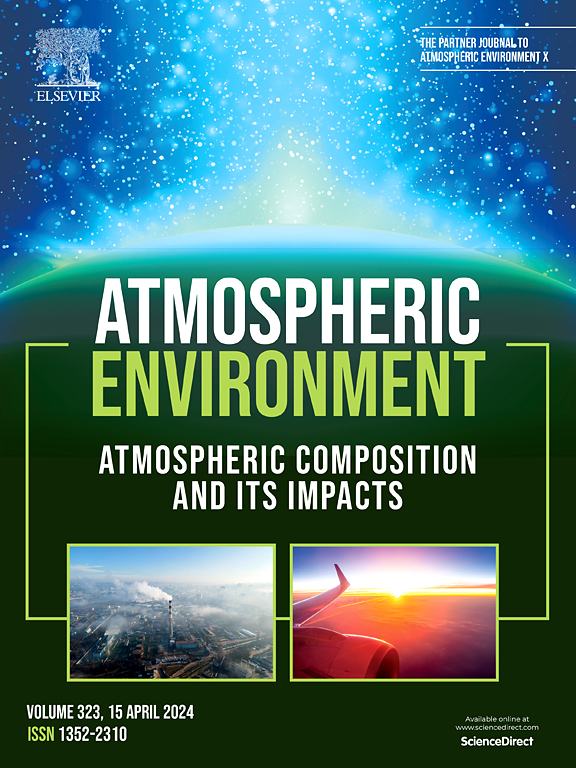The photochemistry of quinones and combustion-derived particles in forming hydroxyl radicals and singlet oxygen in the atmosphere
IF 4.2
2区 环境科学与生态学
Q2 ENVIRONMENTAL SCIENCES
引用次数: 0
Abstract
Polycyclic aromatic hydrocarbons (PAHs) are byproducts of combustion processes and can undergo photooxidation in cloud water upon being emitted into the atmosphere. Quinones are among the products formed from the photochemical aging of PAHs and can undergo subsequent reactions to form environmentally persistent free radicals (EPFRs) and reactive oxygen species (ROS). This study showed that 9,10-anthraquinone (9,10-ANTQ), 1,4-anthraquinone (1,4-ANTQ), and 1,4-naphthoquinone (1,4-NAPQ) undergo different pathways when forming ROS. Singlet oxygen (1O2), which was monitored during the photoaging of these quinones, formed logarithmically over time in low yields (0.5 ± 0.1 μM M−1 to 1.6 ± 0.1 μM M−1) with 9,10-ANTQ and 1,4-ANTQ. However, with 1,4-NAPQ, it formed rapidly within the first 5 min, reaching high yields of 21 ± 7 μM M−1, before undergoing decay. This work suggests that 9,10-ANTQ can behave as a photocatalyst to continuously generate hydroxyl radicals (•OH) in the atmosphere; however, it will more likely exist in its triplet state (39,10-ANTQ∗) as an EPFR. Contrarily, 1,4-ANTQ and 1,4-NAPQ will photodegrade into other products that generate ROS. Among these products is juglone, which was shown to generate •OH exponentially upon photoaging as well as degrade into other products. The varying photochemical behaviors between these different quinones help explain the overall photochemistry of combustion-derived particles, which catalytically generated 1O2 and •OH in this study. This work provides insight into the environmental fates of combustion-derived material and their oxidized derivatives and shows the potential of these compounds to generate excess atmospheric ROS.
在大气中形成羟基自由基和单线态氧的醌和燃烧衍生粒子的光化学反应
多环芳烃(PAHs)是燃烧过程的副产物,在排放到大气中时可以在云水中进行光氧化。醌是多环芳烃光化学老化形成的产物之一,可以通过后续反应形成环境持久性自由基(EPFRs)和活性氧(ROS)。本研究表明,9,10-蒽醌(9,10- antq)、1,4-蒽醌(1,4- antq)和1,4-萘醌(1,4- napq)形成ROS的途径不同。单线态氧(1O2)在这些醌的光老化过程中被监测到,在9,10- antq和1,4- antq的低产率(0.5±0.1 μM−1至1.6±0.1 μM−1)下随着时间的推移呈对数形式形成。然而,在1,4- napq中,它在前5分钟内迅速形成,在发生衰变之前达到21±7 μM−1的高产率。这项工作表明9,10- antq可以作为光催化剂在大气中连续产生羟基自由基(•OH);然而,它更有可能作为EPFR以三态(39,10- antq *)存在。相反,1,4- antq和1,4- napq会光降解为产生ROS的其他产物。这些产物中有核桃酮,它在光老化时呈指数级生成•OH,并降解成其他产物。这些不同醌之间不同的光化学行为有助于解释燃烧衍生颗粒的整体光化学,在本研究中催化生成1O2和•OH。这项工作提供了对燃烧衍生材料及其氧化衍生物的环境命运的深入了解,并显示了这些化合物产生过量大气ROS的潜力。
本文章由计算机程序翻译,如有差异,请以英文原文为准。
求助全文
约1分钟内获得全文
求助全文
来源期刊

Atmospheric Environment
环境科学-环境科学
CiteScore
9.40
自引率
8.00%
发文量
458
审稿时长
53 days
期刊介绍:
Atmospheric Environment has an open access mirror journal Atmospheric Environment: X, sharing the same aims and scope, editorial team, submission system and rigorous peer review.
Atmospheric Environment is the international journal for scientists in different disciplines related to atmospheric composition and its impacts. The journal publishes scientific articles with atmospheric relevance of emissions and depositions of gaseous and particulate compounds, chemical processes and physical effects in the atmosphere, as well as impacts of the changing atmospheric composition on human health, air quality, climate change, and ecosystems.
 求助内容:
求助内容: 应助结果提醒方式:
应助结果提醒方式:


